Brief

At a Glance
- During much of the Covid-19 pandemic, consumer goods companies and retailers in the US found themselves collaborating out of necessity to ensure the supply of essentials.
- Keeping that collaborative approach can now help them overcome multiple challenges, such as the high cost of e-commerce.
- Many manufacturers and retailers attempt to develop joint business plans, but they often fail.
- A six-step approach helps both parties better focus their efforts and efficiently grow the joint profit pool for all over the long haul.
In the US, the thorny relationship between consumer products manufacturers and the grocery retailers that sell their goods was steadily getting more fraught over the years amid deteriorating retailer economics. Retailers faced the high cost of investing in e-commerce at a time when competition intensified from new channels such as discounters and dollar stores. It all led to increasingly tougher trade negotiations intended to prevent already razor-thin margins from eroding further.
Written in collaboration with
Written in collaboration with

Then the Covid-19 pandemic changed everything. It gave grocery retailers a temporary boost as away-from-home consumption shifted to at-home consumption and as consumers kept stocked up. Meanwhile, suppliers and retailers suddenly found themselves collaborating if only because they needed to—they were in constant communication to ensure supply, and made trade-offs together to simplify assortment to deliver more product and meet elevated demand. In home care categories, for example, manufacturers and retailers cut assortment by 7.4% last year (even while sales increased by 17.3%), according to global measurement and data analytics company NielsenIQ. The collaboration made an impact. In fact, 73% of US retailers improved their supplier relationships in 2020, according to a survey by Advantage Group International, which measures supplier and retailer engagement performance.
Yet the pandemic also accelerated some of the retailing shifts that hurt retailer margins, such as the rising popularity of e-commerce, which is less profitable for retailers (see Figure 1). Based on NielsenIQ data, overall e-commerce sales grew approximately 60% in 2020. Now both parties face the big postpandemic challenge of developing a systematic way to maintain that spirit of collaboration as volume slowly returns to pre–Covid-19 levels, as online penetration (and its associated costs) persists, and as labor costs rise. On top of that, it is likely that future growth will come mostly from market share shifts and inflation, if retailers can pass along price increases to consumers.
Grocery retailers grapple with fulfillment costs that make e-commerce largely unprofitable
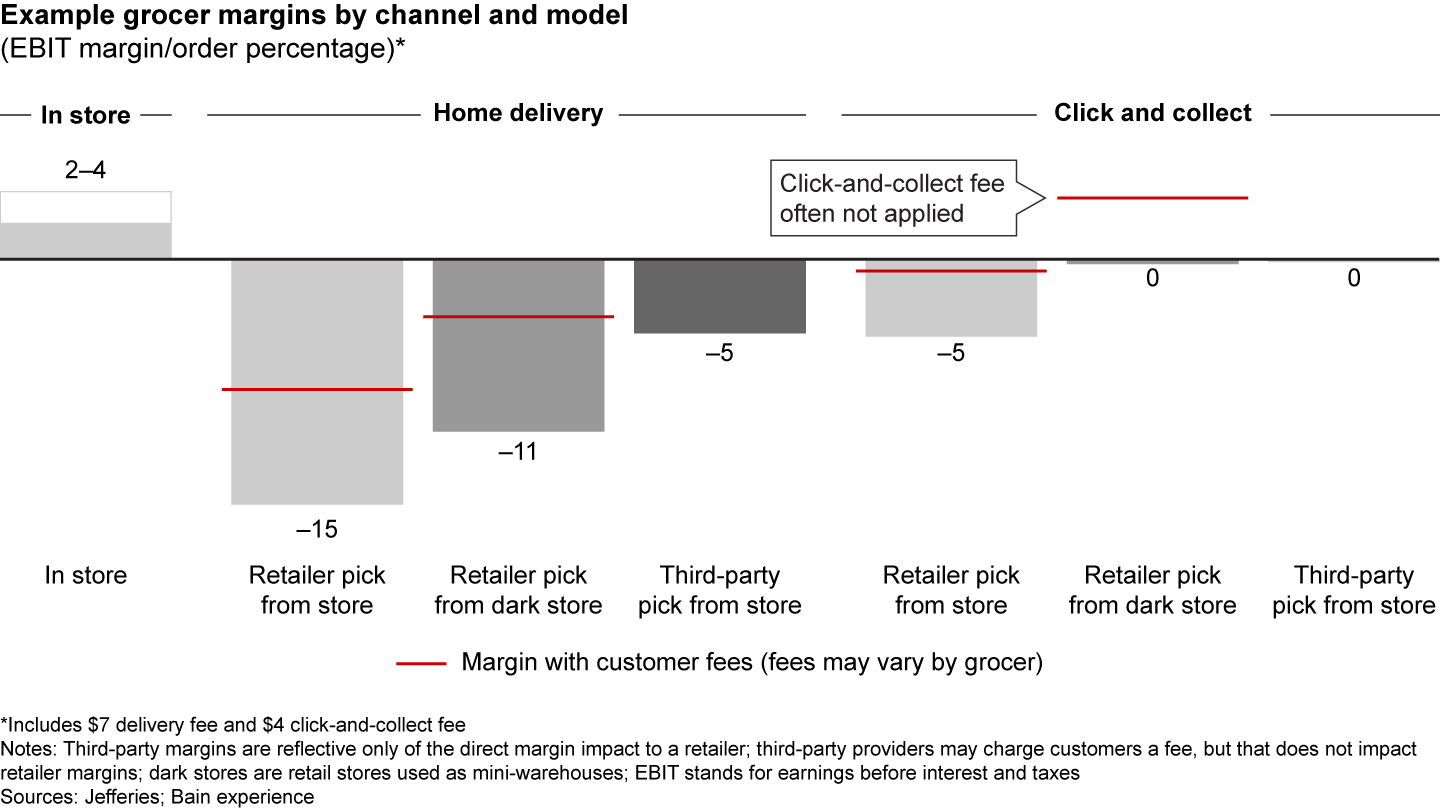
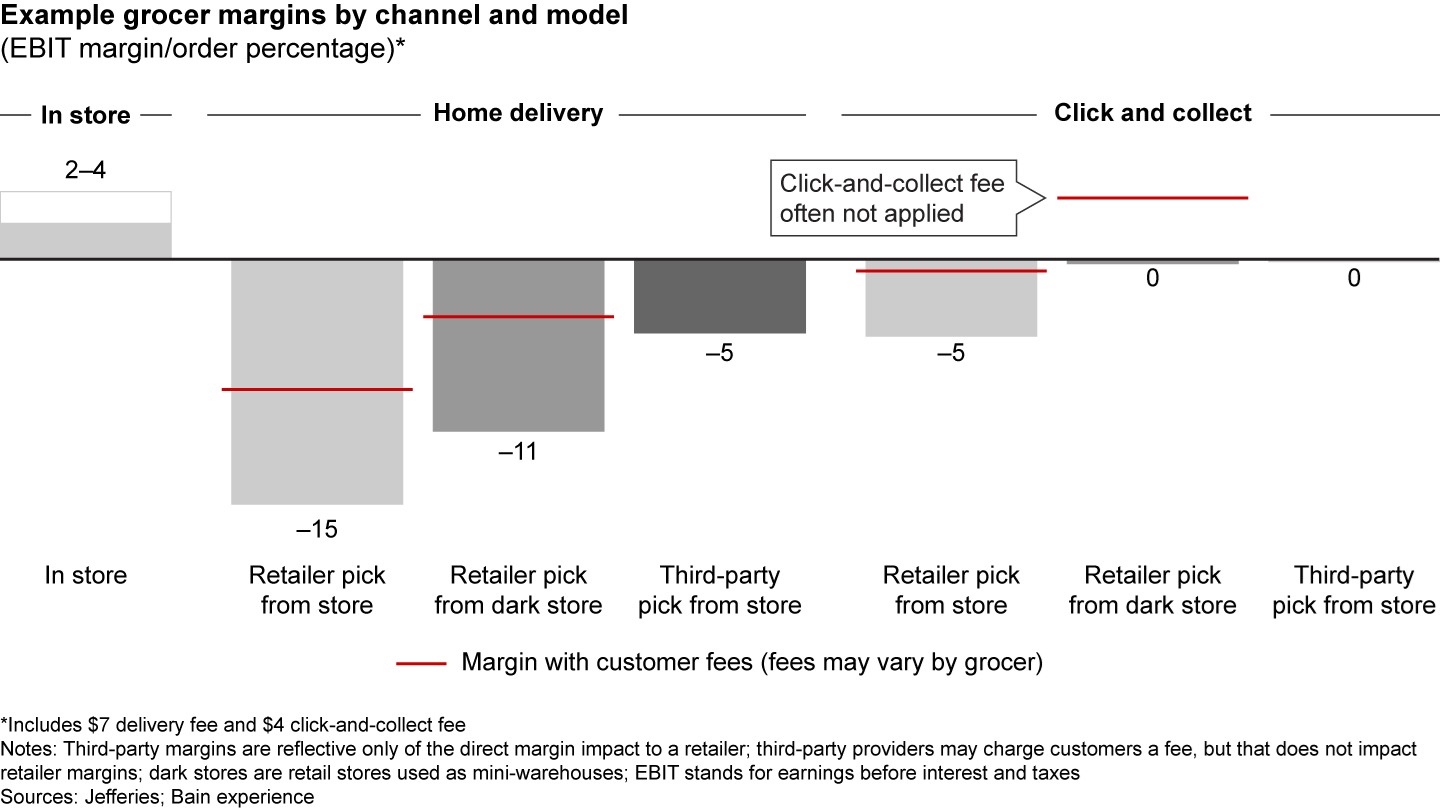
Many suppliers and retailers will find that the key to thriving in this postpandemic world requires collaborating through joint business planning that expands the profit pools and strengthens the business for all. It is a deep, multiyear commitment to increased collaboration, information sharing, and flexibility to improve category growth and profitability for each side. It will help them battle common enemies such as the return of restaurant spending, the steady growth of pure-play e-commerce, and the rise of aggregators like food and grocery delivery services. It will be critical for unlocking growth, creating value, and generating cost savings.
The US is prime territory for expanding the joint profit pool. Unlike in Europe, for example, sales culture in the US traditionally has been more relationship based and less antagonistic. Also, there are no cross-border issues, retailers are larger, and high-quality market data is readily available to support collaborative planning (see the Bain Brief “Growing the Joint Profit Pool of Retailers and Manufacturers in Europe,” the first in Bain’s series on joint profit pools).
While nearly every consumer goods company and retailer has a joint business planning process, most are incomplete and built off decades-old interaction models. Despite aligned interests, and even with the best of intentions, a number of things thwart both parties. There’s often a lack of transparency on data and aims. There are siloed interactions on both sides (and between sides). There often are inefficient exchanges—where parties talk past each other or don’t perform the right prework to make the most of meetings. And an adversarial zero-sum game mentality still prevails. As evidence of this challenging situation, consider that retailers perceive the average consumer products company as not being a great partner. According to data by Advantage, which annually surveys suppliers and retailers, the disparity is widening between those suppliers that are viewed as best in class by retailers and the rest of the pack. While the top five suppliers earned an average performance score of net favorable 46, the industry average has dropped to 20 in 2020 from 23 in 2017 (see Figure 2).
US retailers’ perception of suppliers is low and dropping on average—but the top five rise above the pack
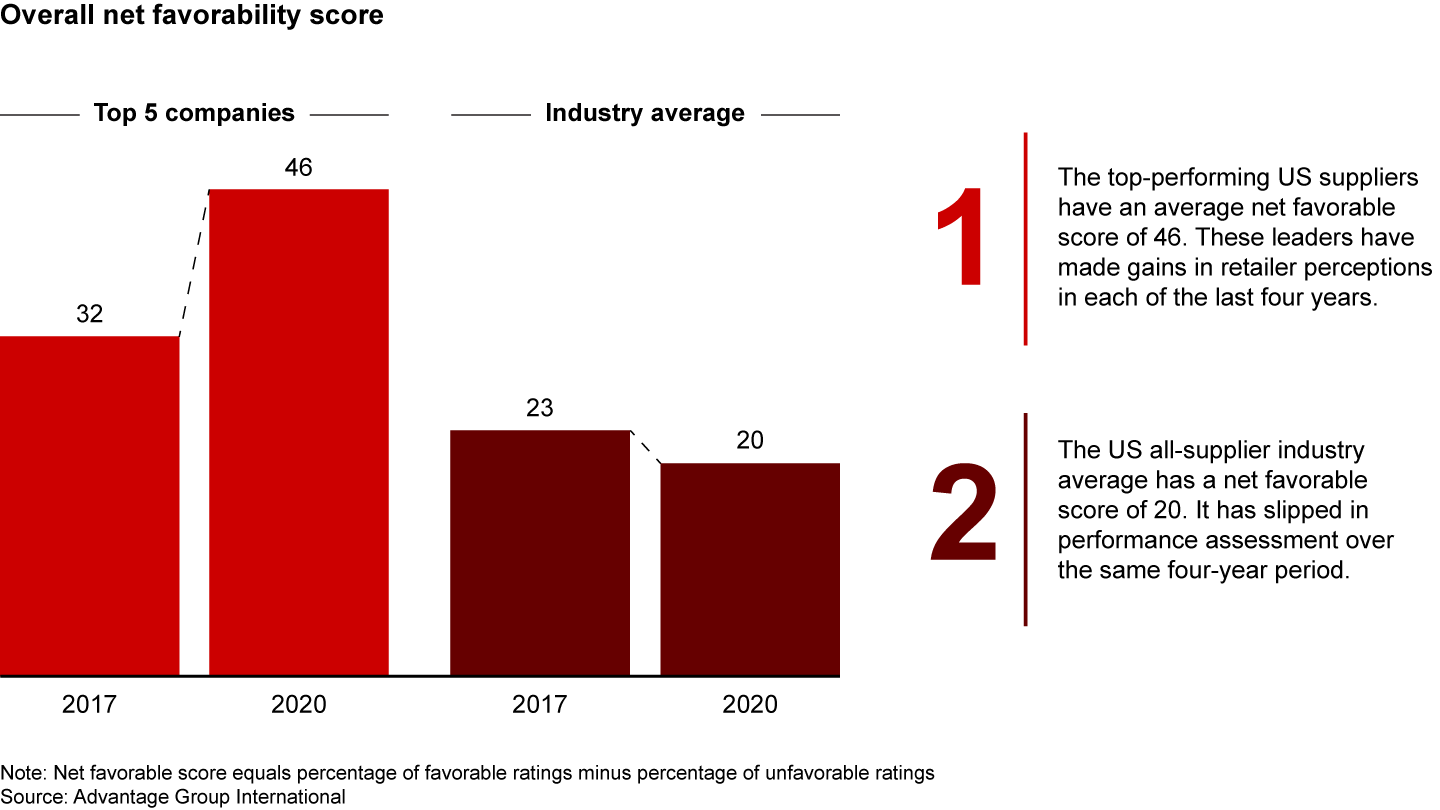
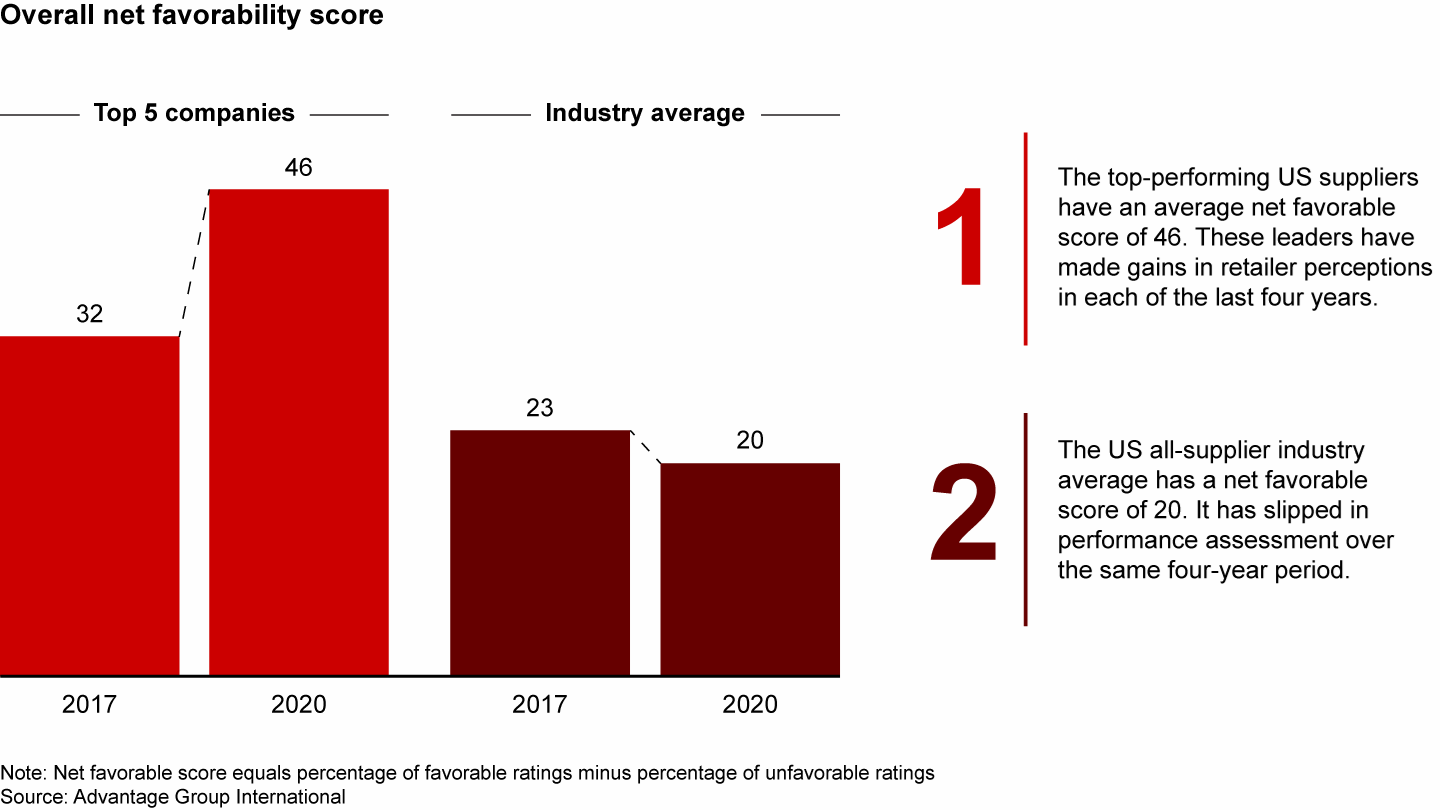
But some are succeeding in helping each other grow. When a manufacturer and grocery retailer collaborated recently to slow channel shift for a particular product category, they jointly tested a new aisle design that showcased innovation and assortment range. The retailer wanted growth, but the consumer goods company also wanted growth in breadth of assortment. The results were strong enough that both parties agreed to roll out the changes across the chain, with mutual long-term growth targets and with the consumer goods company making the necessary capital investments to support the effort. As part of the collaborative approach, the companies also teamed up for a digital marketing program to mutually benefit from data sharing and personalization.
What separates the winners from the others? The best-performing consumer goods companies and retailers take a systematic approach to pinpointing new areas for growth, cocreating innovations that expand categories and generating meaningful system cost reductions—with the overall benefit of delivering incremental profit pool growth for both sides.
Here is what it takes.
Decide where to focus your efforts. As a starting point, companies need to acknowledge that not every supplier is critically important to every retailer and vice versa. So, there is a strategic choice to be made about where to place scarce partnership time and resources. The best-aligned growth plans will boost categories—but also shift share from competitors on both the retail and consumer goods side.
Likewise, it is important to recognize at the very beginning that there are some areas where there will always be win/lose propositions, such as private-label penetration and “on-time in-full” fines.
But there are far more opportunities for collaboration. For example, while the pandemic-inspired e-commerce boost experienced by many manufacturers and retailers accelerated the shift to digital, we are still in early innings. There is much more digital penetration to capture and opportunity to get it right. Companies can team up to improve the e-commerce experience for consumers and their own performance. They can collaborate on how to boost category participation, capture digital impulse shopping, and drive substitutions that benefit all. Moreover, they can leverage their combined supply chain network for total system cost reductions and reclaim trade funding, spending, and consumer data from intermediaries and alternative channels.
Understand the other side’s strategy and P&L. Too often each side has a view of their partner’s aims that is too high level. As a result, they cannot clearly understand what the other party is really trying to accomplish—something that’s critical for creating win-wins. Understanding each other’s strategy is a key contributor to high perception scores, according to Advantage, with top suppliers rating 42% higher and top retailers rating 127% higher than the pack on that dimension, with their respective partners.
Consumer goods companies need to determine which shopper segments a retailer is targeting and the role their category plays in the department or overall store, for example. They need to determine where the retailer is planning to make investments and the specific competitors from which they want to capture share of wallet.
For their part, retailers must understand how a supplier is evolving its portfolio, the role a category plays in its broader business, and the competitors from which it wants to—or needs to—take share.
Meanwhile, companies on both sides need to understand how the partner’s profit and loss statement is evolving, and what the true profitability picture and go-forward goals are.
Consider the example of one consumer goods company that was able to deconstruct category performance to show that it had been responsible for most of the profit creation for the retailer in that category—but at the expense of top-line growth. The manufacturer demonstrated that growing together could yield increased operating profit for both sides, given the superior margin profile.
Recognize that their timeline and planning horizon may be different from yours—and when to use theirs. Generally speaking, suppliers need to follow the retailer’s schedule. Small retailers should think about adopting large retailers’ schedules or about matching a supplier’s innovation and planning timeline. Despite the rapid advance of insurgents and a broad desire for agility, the reality is that lengthy timelines are the norm for most retailers and suppliers. These systematic calendars set the cadence for the year—growth summits, line reviews, negotiations, and shelf resets. While all sides should strive for faster cycles, harnessing the framework can create better outcomes—and the proper space and time for different types of conversations. In our experience, when companies ignore the longer timelines, they may be able to muscle through an off-cycle introduction but end up paying for it with massive amounts of additional effort, enormous expectations, and the likelihood that the retailer will just swap in the new product for an existing one or reclaim supplier space at the next reset.
Be transparent on areas where there is value to be created—and pick one or two issues to go really deep, where you can share the benefits and costs. There are a few clear areas where deep collaboration can create real value in the current environment—category growth plans, assortment simplification, e-commerce partnerships, sustainability agendas, or meaningful system cost reduction via supply chain coordination. Others are inflation, service levels, store traffic, and resetting aisles. In each of these areas, companies can benefit from bringing together knowledge and resources where neither side has a monopoly.
In e-commerce, that can mean collaborating on media, data, and total cost to serve by working together on data sharing and forecasting, for example. Consumer goods companies can help retailers with landing pages and have the capability and resources to generate and share deep insights on shopper decisions online vs. in store to generate incremental category participation, basket size, and growth. Both sides can reduce cost to serve by exploring drop shipping, creating optimized layouts, and improving packaging for ease of picking. And retailers can cost share by having brands subsidize delivery fees or advertise on their own media networks. This likely means working through the costs and benefits of any initiative and agreeing to share the bigger pie (e.g., shelf-ready packaging, precision shopper targeting)—but with clarity on the joint economics. It also could involve shifting digital spending from aggregators to initiatives where retailer and consumer goods company see the highest joint benefit.
Raise the number and quality of customer touchpoints—but do it in service of a bold ambition. Both sides need to get the right team together, with representation not only from sales and marketing, but also from finance, supply chain, and insights. Create a web of touchpoints across different functions, and make sure that you are talking to your counterparts often enough to get to second-order answers on what is possible. Participants must be empowered to make decisions that could be uncomfortable. Whether that means shorting other retailers to ensure product flow, shifting displays between categories to support enough merchandising, or tying up the top results on an e-commerce category page, good plans should require investment that isn’t a sure bet.
Also important: focusing on the issues that would deliver a prize that is big enough to justify the time commitment. That requires sufficient prework, internal analysis, and sharing real data and insights with the other side.
Track the progress. Commit to shared goals, and have simple joint scorecards that tell you the score. Ideally, these have carrots and sticks.
The best joint plans include committed growth targets, with agreements on range of assortment, total shelf slots, merchandising support, and even inventory levels. The overall goal is nearly always about joint top-line growth. These growth targets should be tied to laddered trade or cost-of-goods-sold incentives so that higher growth—either at the category or total supplier level—yields additional margin gains to the retailer, making the share shift worthwhile for both sides (and painful if undelivered). Create a shared scorecard that both companies can use to track progress and as a reference to guide additional efforts.
The pandemic gave consumer goods companies and retailers in the US a clear picture of what they can gain through seamless collaboration. Now, as both sides face the prospects of pursuing profitable growth in the postpandemic world, the companies that find a way to work together to jointly grow their profit pools will establish the enduring relationships and processes that will enable them to outpace competitors—no matter what the future brings.

About Nielsen Holdings
Nielsen Holdings is a global measurement and data analytics company. Nielsen Global Media provides media and advertising industries with unbiased metrics that create a shared understanding of the industry. Nielsen Global Connect provides CPG companies with accurate, actionable insights that companies need to grow. An S&P 500 company, Nielsen operates in over 90 countries. For more information, visit www.nielsen.com.
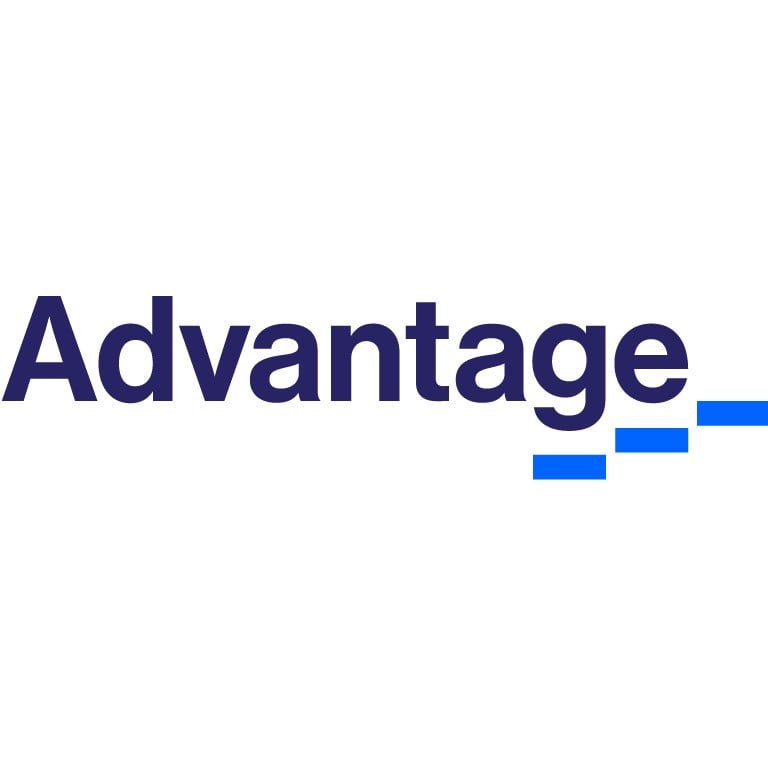
About Advantage Group International
Advantage has been the leading adviser in business-to-business engagement globally since 1988. We help supplier and retail businesses be better together by designing and delivering engagement solutions that measure and strengthen performance. For more information, visit www.advantagegroup.com.